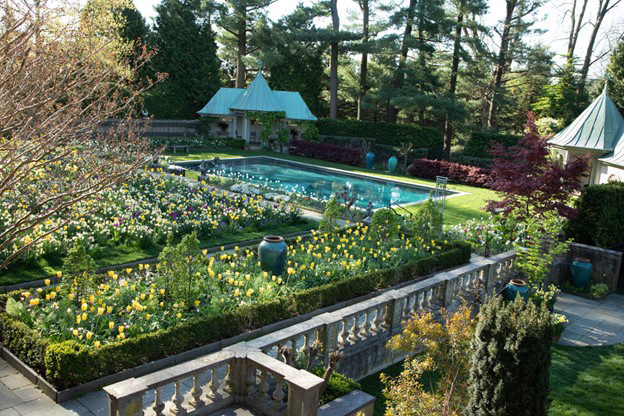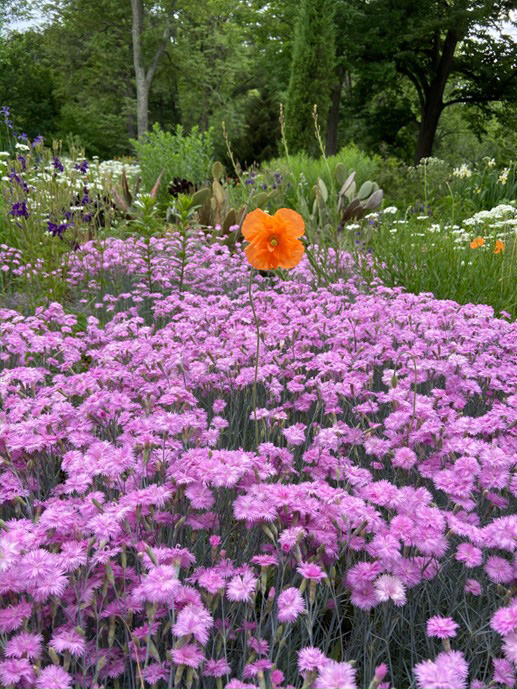
Spring can be one of the most colorful times of year in the garden, but it can also be one of the sparest. Here at Chanticleer, a public garden in Wayne, Pennsylvania, we have found that some clever choreography and creative handiwork can help the garden to seem full, even when some of our summer favorites are still sleeping in. Here is some garden design inspiration from Chanticleer that could translate easily to almost any home garden.

Garden Design Inspiration From Chanticleer
Synchronize moments
These Chinese snowball viburnums (Viburnum macrocephalum, Zones 6–9) will put on quite a show regardless of their setting, but their impact is amplified by an underplanting of Spanish bluebells (Hyacinthoides hispanica, Zones 3–8). The combination is nothing complicated or extravagant, but a simple understanding of timing has transformed this frame of flowers into a vignette that will stand out in visitors’ minds.

Plant BIG
This photo of daffodils (Narcissus ‘Ice Follies’, Zones 3–8) may be taking the point to an extreme, but flowers read better in masses. Instead of buying 20 of a few different varieties of tulips, try 200 of one. Plant some into foregrounds and more into backgrounds of frequent vistas. Suddenly, even the dormant plants will look animated and alive.

Don’t forget about edibles
Though they are often overlooked, we find that many edibles are invaluable in spring plantings. Already the product of years of agricultural breeding, these plants are showy, cold hardy, fast-growing, widely available, and affordable. This particular arrangement, which includes purple kale and yellow-stemmed Swiss chard, has the added benefit of matching the colored tiles in Chanticleer’s Kitchen Courtyard.

Make promises of garden moments to come
As spring is the beginning of the gardening season in some ways, it is also the season of intentions. As such, there is a certain element of drama in empty spaces. Our eye goes immediately to the vacant turquoise pot in this bed of yellow tulips. The color combination is a statement on its own, but will the urn be planted later? At Chanticleer, we incite similar questions elsewhere in the garden with cut branches and stakes. Guests may wonder, “What will grow up in them? How tall will the plants be?” Sometimes these elements are for sculpture and sometimes for utility, but they are always fodder for conversation.

Befriend the volunteers
We have all been planning our gardens over the winter, but Mother Nature has been busy too. What can be learned about the garden by the plants that survived and those that succumbed? There is always an element of randomness and wildness in the garden, and this is a force best embraced. Here, a single Spanish poppy (Papaver rupifragum, Zones 6–10) could easily be charged with spoiling the carpet of ‘Mountain Mist’ pinks (Dianthus ‘Mountain Mist’, Zones 3–9) below it. But hasn’t the garden’s mood changed by keeping it? This lighthearted nod tells the observer that we are gardening with the wilds, laughing at its pranks and rejoicing in its vigor as it awakens once again.
Chanticleer is a 35-acre pleasure garden featuring contemporary designs within a historic setting. It is located in Wayne, Pennsylvania, about 30 minutes west of Philadelphia.
For a classic video about Chanticleer’s container-gardening design process, check out: Making Containers at Chanticleer
Here’s a Garden Photo of the Day entry that shows some exuberant summer displays at Chanticleer: GPOD on the Road: Chanticleer
—Timothy Erdmann is an assistant horticulturist at Chanticleer garden in Wayne, Pennsylvania.

















Comments
Log in or create an account to post a comment.
Sign up Log in